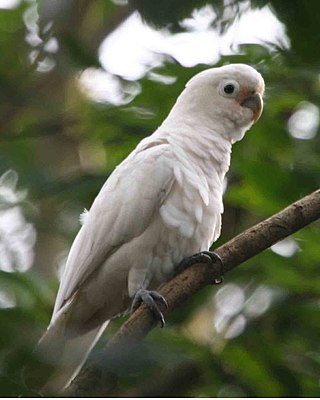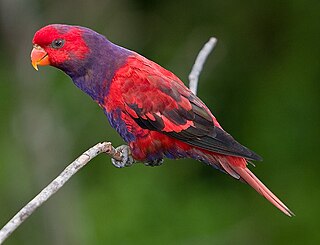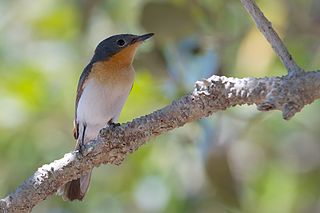
A cockatoo is any of the 21 species of parrots belonging to the family Cacatuidae, the only family in the superfamily Cacatuoidea. Along with the Psittacoidea and the Strigopoidea, they make up the order Psittaciformes. The family has a mainly Australasian distribution, ranging from the Philippines and the eastern Indonesian islands of Wallacea to New Guinea, the Solomon Islands and Australia.

The Tanimbar corella, also known as Goffin's cockatoo or Tanimbar cockatoo, is a species of cockatoo endemic to forests of Yamdena, Larat, and Selaru, all islands in the Tanimbar Islands archipelago in Indonesia. It has been introduced to the Kai Islands, Indonesia, Puerto Rico, and Singapore. This species was only formally described in 2004, after it was discovered that the previous formal descriptions pertained to individuals of a different cockatoo species, Ducorps' or Solomons cockatoo. Tanimbar corellas are the smallest of the white cockatoos. It is classified as near threatened due to deforestation and cage-bird trade. It breeds well in captivity and a large avicultural population exists.

The white cockatoo, also known as the umbrella cockatoo, is a medium-sized all-white cockatoo endemic to tropical rainforest on islands of Indonesia. When surprised, it extends a large and striking head crest, which has a semicircular shape. The wings and tail have a pale yellow or lemon color which is exposed when they fly. It is similar to other species of white cockatoo such as yellow-crested cockatoo, sulphur-crested cockatoo, and salmon-crested cockatoo, all of which have yellow, orange or pink crest feathers instead of white.

The Solomons corella, also known as Solomons cockatoo, Ducorps's cockatoo or broad-crested corella, is a species of cockatoo endemic to the Solomon Islands archipelago. This small white cockatoo is larger than the Tanimbar corella yet smaller than the umbrella cockatoo. The species is common across most of the Solomons, absent only from Makira in the south. It inhabits lowland rainforests, secondary forests, cleared areas and gardens.

The Moluccan eclectus is a parrot native to the Maluku Islands (Moluccas). It is unusual in the parrot order for its extreme sexual dimorphism of the colours of the plumage; the male having a mostly bright emerald green plumage and the female a mostly bright red and purple/blue plumage. Joseph Forshaw, in his book Parrots of the World, noted that the first European ornithologists to see eclectus parrots thought they were of two distinct species. Large populations of this parrot remain, and they are sometimes considered pests for eating fruit off trees. Some populations restricted to relatively small islands are comparably rare. Their bright feathers are also used by native tribespeople in New Guinea as decorations.

Eclectus is a genus of parrot, the Psittaciformes, which consists of four known extant species known as eclectus parrots and the extinct Eclectus infectus, the oceanic eclectus parrot. The extant eclectus parrots are medium-sized parrots native to regions of Oceania, particularly New Guinea and Australia. Males are mostly bright green, females are predominantly bright red. The male and female eclectus were once thought to be different species. The conservation status of the remaining species is least concern. Eclectus parrots do well in captivity, and are a very popular pet across the world.

The glossy black cockatoo, is the smallest member of the subfamily Calyptorhynchinae found in eastern Australia. Adult glossy black cockatoos may reach 50 cm (19.5 in) in length. They are sexually dimorphic. Males are blackish brown, except for their prominent sub-terminal red tail bands; the females are dark brownish with idiosyncratic yellow marking around the neck and prominent sub-terminal tail band of red with black bars. Three subspecies have been recognised, although this has been recently challenged, with a detailed morphological analysis by Saunders and Pickup 2023 finding there is cline in body dimensions over the latitudinal range of the species, with the birds from the north of the range smaller than the birds in the south. Saunders and Pickup argued that with no differentiation in bill morphology, little difference in genetic makeup, no differences in plumage pattern or colour, and no differences in diet, there is no justification in subdividing the species.

Psittaculini is a tribe of parrots of the family Psittaculidae. The subdivisions within the tribe are controversial.

The short-tailed parrot is a species of bird in subfamily Arinae of the family Psittacidae, the African and New World parrots. It is found in Brazil, Colombia, Ecuador, French Guiana, and Peru.

Wallace's fruit dove is a species of a bird in the pigeon family Columbidae. The name commemorates the British naturalist Alfred Russel Wallace. It is a rather large, long-tailed fruit dove with a length of 24–28 cm (9.4–11.0 in) and has been described as "one of the most beautiful" fruit doves. The forehead and crown are dull crimson, the lower face and throat are white, and the rest of the head, breast, neck, and upper back are pale bluish-grey. The wings and lower back are green and the belly is orange, separated from the chest by a white band. Both sexes look similar, but females have less extensive red on the head and a greenish tinge to their grey parts.

Alisterus is a genus of medium-sized Australasian parrots, comprising the Australian king parrot, the Papuan king parrot and the Moluccan king parrot. The three species are respectively found in eastern Australia, Papua, the Moluccas and other Indonesian islands. Predominantly of red and green plumage, the long-tailed parrots are related to the genera Aprosmictus and Polytelis.

The yellow-billed amazon, also called the yellow-billed parrot or Jamaican amazon, is a species of parrot in the family Psittacidae. It is a predominantly green parrot with a short tail and pink throat and neck. It is endemic to Jamaica, where its natural habitats are subtropical or tropical moist lowland forests, subtropical or tropical mangrove forests, subtropical or tropical moist montane forests, plantations, and rural gardens. It is threatened by habitat loss and illegal trapping of wild birds for the pet trade.

The violet-necked lory is a species of parrot in the family Psittaculidae. It is endemic to Indonesia, where it is found in the northern Maluku Islands and west Papuan islands. Its natural habitats are tropical moist lowland forests and tropical mangrove forests.

The red-cheeked parrot is a species of parrot in the family Psittaculidae found in Indonesia, Papua New Guinea and the tip of northern Queensland, Australia. There are 17 subspecies currently recognized. It is a stocky short-tailed parrot with predominantly green plumage. It exhibits sexual dimorphism; the adult male has red cheeks and a mauve nape and top of head, while the female is duller with a brown head.

The broad-billed flycatcher is a species of bird in the family Monarchidae. It is found in northern Australia, the Lesser Sunda Islands and southern New Guinea. Its natural habitats are subtropical or tropical moist lowland forest, subtropical or tropical mangrove forest, and subtropical or tropical moist montane forest.

The oceanic eclectus is an extinct parrot species which occurred on Tonga, Vanuatu and possibly on Fiji. Its closest living relative is the eclectus parrot, which has proportionally larger wings than the oceanic eclectus parrot. The fossil material unearthed in November 1989 in Late Pleistocene and Holocene deposits on 'Eua, Lifuka, 'Uiha and Vanuatu and described in 2006 by David William Steadman include a complete femur, five radii, a quadrate bone, a mandible, a coracoid, two sterna, two humeri, two ulnae, two tibiotarsi, a carpometacarpus, a tarsometatarsus, and three pedal phalanges.

The parrot subfamily Psittaculinae consists of three tribes: the Polytelini with three genera, the Psittaculini or Asian psittacines, and the pygmy parrots of the Micropsittini tribe.

The coconut lorikeet, also known as the green-naped lorikeet, is a parrot in the family Psittaculidae. Seven species of lorikeets now recognised were once lumped together under Trichoglossus haematodus.

The Papuan eclectus, red-sided eclectus, or New Guinea eclectus is a parrot species which is native to New Guinea. Larger than the Moluccan eclectus, the green plumage of the male only has a slight yellow tinge and the tail is tipped with a half-inch yellow band. The central tail feathers are green and lateral ones blue and green. It is widely distributed from Kai Islands and western islands of the West Papua province in the west, across the island of New Guinea to the Trobriands, D'Entrecasteaux Islands, Louisiade Archipelago, Bismarck Archipelago, and Solomon Islands to the east, and south to the northern Cape York Peninsula of Australia. It has also been introduced to the Goram Islands, Indonesia.

The Sumba eclectus, or Cornelia's eclectus is a parrot species which is native to Sumba. Also larger than the Moluccan eclectus, the male is a paler shade of green overall and has a bluer tail. The female has an all red plumage, except for the primaries which are a dark royal blue, and can be differentiated from the Tanimbar eclectus by the lack of yellow to her tail.





















